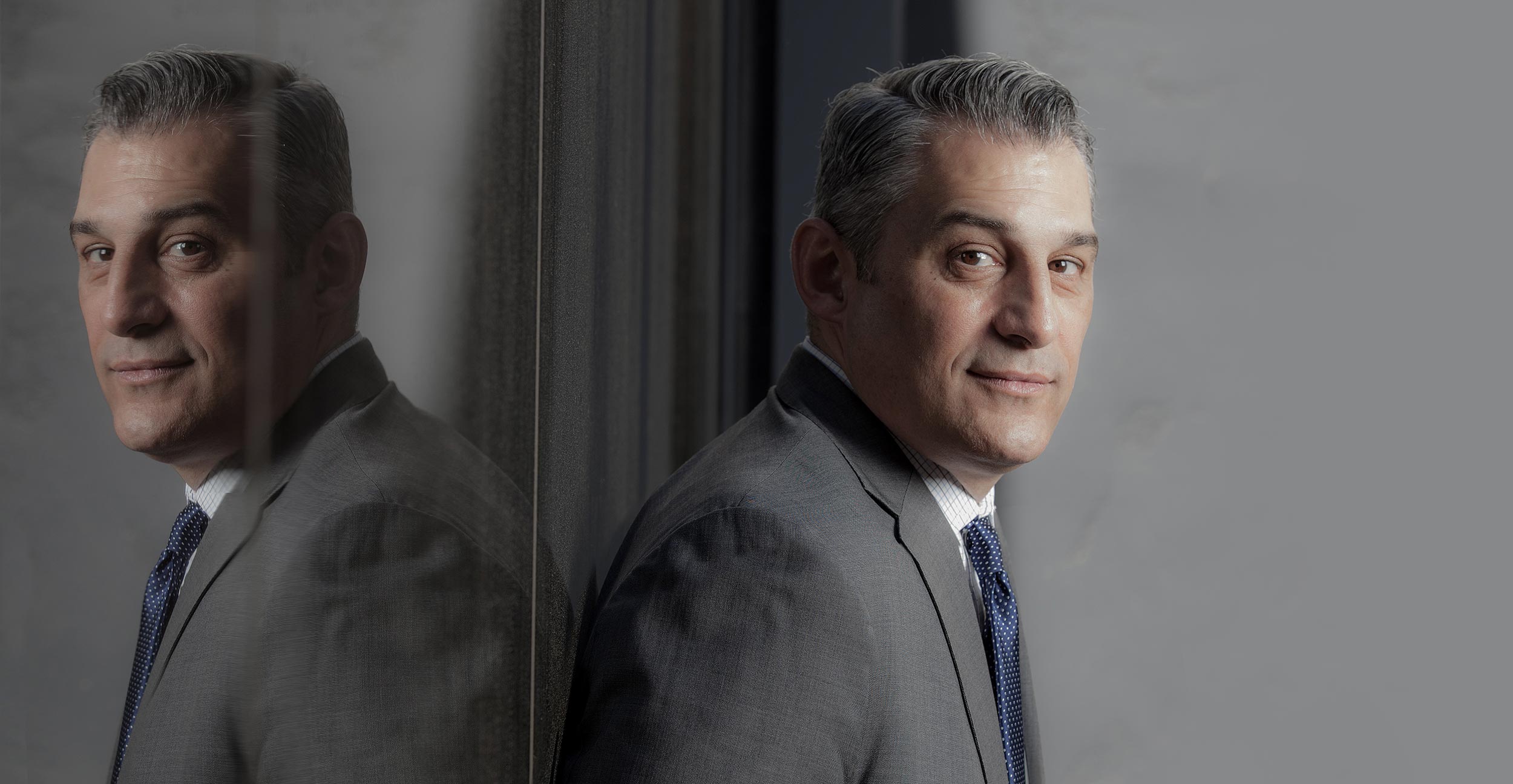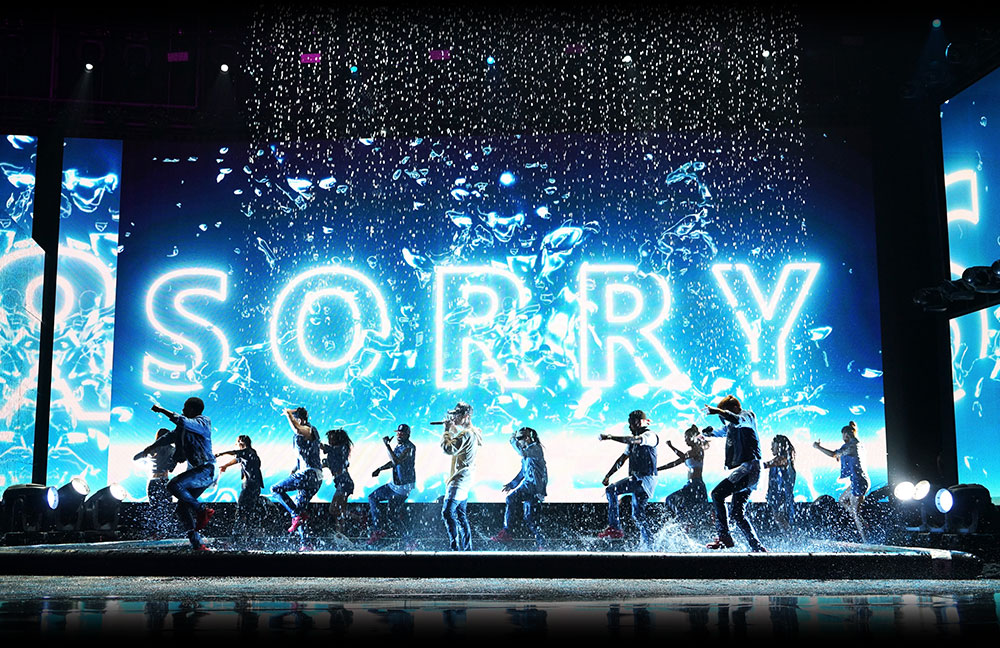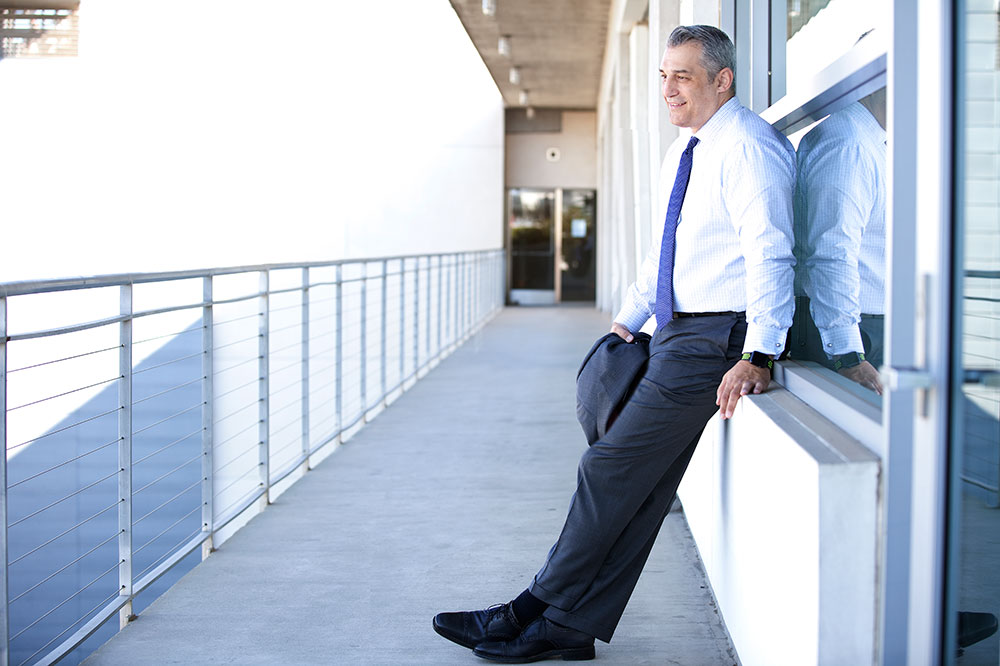
Three decades ago Greg Economou '88 (CLAS) was playing for Coach Calhoun. These days, he's the man behind the curtain of spectacles like "New Year's Rockin' Eve," the American Music Awards, and the Golden Globes. The former Husky says many of Calhoun's principles still apply.
By Robert Ito
Photographs by James Stenson

Three decades ago Greg Economou '88 (CLAS) was playing for Coach Calhoun. These days, he's the man behind the curtain of spectacles like "New Year's Rockin' Eve," the American Music Awards, and the Golden Globes. The former Husky says many of Calhoun's principles still apply.
By Robert Ito
Photographs by James Stenson

If you're chosen to be the closing act of the American Music Awards, you go big. So when Justin Bieber got the job in 2015, his show featured laser lights, break dancers, thousands of hot pink glow sticks color-matched to the stage, and mammoth video screens three times as tall as the pop star himself. Seconds before his final song, the heavens opened up inside L.A.'s Microsoft Theater and unleashed torrents of water, digital and actual, onto the heads of Bieber and his crew of dancers. The crowd, predictably, went wild.
If you enjoyed the performance, you have Greg Economou to thank. Economou didn't rig the lights or cue the rain, but the show wouldn't — and couldn't — have gone on without him. Same with the six-song medley Britney Spears performed at the 2016 Billboard Music Awards or Jason Aldean's star turn at the most recent Academy of Country Music Awards.
Economou is the executive vice president and chief revenue officer for Dick Clark Productions, which produces awards shows from the Golden Globes to the Billboard Music Awards to the AMAs. The shows are lavish affairs staged in some of the country's most iconic venues: the MGM Grand in Las Vegas, the Beverly Hilton, Dallas' AT&T Stadium. All of this costs. Bob Romeo, CEO of the Academy of Country Music, had one word to describe the price tag on their 2015 show: staggering.
So who pays for all this? In the old days, it was TV commercials. But now, as budgets have exploded and audiences are just as likely to watch the shows on their laptops and cell phones as on their TVs, funding these massive productions has gotten exponentially more complex. And with increasing costs, mega-sponsors like Coca-Cola and T-Mobile aren't satisfied with just existing between show segments. They want in on the show — and on your phone, and on your favorite social media sites. Economou and his team at Dick Clark oversee all of it, engineering deals that straddle everything from branded programming — like Bieber's 2015 AMA show, aka "The AMA T-Mobile Finale" — to preshow red carpet clips posted on Facebook and YouTube. Picture the aspirational sales pitches of Don Draper and the in-the-moment quarterbacking of Peyton Manning, and you'll get a small sense of what Economou does for a living.
Under all those championships banners and retired jerseys, amid all those cameras and screaming fans, Economou sank his first shot, a three pointer.


Number 23, Greg Economou, went from being a UConn walk-on to starting in a game at the Boston Garden. Years later he would find himself working in sales at Madison Square Garden. These days he's in Hollywood at Dick Clark Productions, where he's a rainmaker, sometimes literally — as with Justin Bieber's wet and wild "Sorry" finale at the 2015 American Music Awards.
Economou is in his third-floor corner office at Dick Clark Productions in Santa Monica, explaining how he came to be here. At 51, Economou is tall (6'3") and fit, with more than a passing resemblance to a young Robert De Niro, circa "The Godfather Part II." Before he came to Dick Clark, Economou worked a variety of sales gigs, for entities that sold themselves (Madison Square Garden, the NBA) and others that, well, did not (the now-defunct Charlotte Bobcats). Before that, he played basketball under legendary UConn coach Jim Calhoun, back before UConn basketball was UConn Basketball, writ large. On that overperforming team he learned something he's carried with him to every gig and challenge, big or small, ever since. "You just have to outwork people," he says.
Economou was never supposed to be a starter for UConn. A strong player in high school, he was on intramural squads his first three years of college. When he finally made the team, it was as a walk-on, one of four little-used players. If a pal of his, team captain Gerry Besselink, hadn't seen him play in pickup games and told his coach, hey, you ought to give this guy a look, he wouldn't have been there at all. But there he was, and there was Calhoun, a granite cutter and gravedigger before becoming one of the NCAA's winningest coaches, grabbing him after practice. "You're gonna start against BC," he told Economou. Boston College. In a nationally televised game in storied Boston Garden, home of Larry Bird and that iconic parquet floor. Do your thing, Calhoun told him. Play hard.
Economou had slipped in practice the day before and was nursing a groin pull, but Calhoun didn't know that. Who was going to tell him? Certainly not Economou. Nothing was keeping him out of that game. Under all those championship banners and retired jerseys, amid all those cameras and screaming fans, Economou sank his first shot, a three pointer, then went four for four at the foul line after a poke in the face from a BC player left him with only one good eye. UConn won, 66"“60, ending a six-game losing streak against their rival. The Cinderella story was so improbable, its hero so unlikely, that it was written up in The New York Times that week with the headline "Walk-on Takes Big Strides."
"It was a fairy tale," Economou remembers.
That fairy tale had its beginnings in Montrose, New York, a tiny town about an hour from Manhattan by train. That's where Economou was born and raised, the middle son of three. His father was a high school principal and college professor; his mother taught eighth-grade English at the same school for 35 years. A three-sport athlete, he was the guy you'd see shooting baskets for hours in his folks' driveway while his friends were hanging out at the park. "I wasn't the best athlete, but I was really dedicated," he says.
After graduating from UConn in 1988, Economou was drafted by Olympiakos, a Greek pro basketball team. A proud Greek on his dad's side, Economou got to meet relatives in his home country, reconnect with his Greek heritage, and see parts of the world closed to many Americans at that time. He played in Moscow during the waning days of the Cold War. He toured areas of southern Poland so impoverished that people stood in lines without even knowing what they were there for. "They need everything, so when they see a line, they get in it," a tour guide explained to him.
Three years later, after a debilitating back injury, Economou returned to UConn to work in the athletic department. It was there, he says, that he caught the fundraising bug. It was more than just taking folks out golfing and schmoozing donors over steak dinners, he quickly learned. There was an art and science to it all, whether you were engineering huge corporate deals or getting alums to open their wallets for the annual drive. "I liked both sides," he says.
The next year, Lou Perkins, UConn's athletic director at the time, recommended Economou for a position running external affairs for the athletics department at SUNY Stony Brook. The university was trying to move up the ranks to Division I, but its sports program was eclipsed in popularity and community love by, of all things, the local high school. Even worse, both shared the same team name, the Patriots. Economou went to work, helping create a flashier logo and fiercer nickname (the Seawolves). The reboot was a success. "I didn't really know anything about branding," Economou says. "All I knew was, I wanted to get out of the shadow of that high school."

What if the branding strategies used to market Knicks games and the NBA finals could be applied to, say, the American Music Awards?
He was a quick study. Sports team branding was in its infancy, and over the next decade, Economou headed marketing and branding teams for everyone from the L.A. Kings and the University of Alabama to the Houston Rockets and NASCAR. In 2010, he got another opportunity, a la Stony Brook, to build a team's marketing program from the ground up. The team was the Charlotte Bobcats, one of the most unpopular squads in NBA history. A new team and a poor one, it was hated even in Charlotte, which had recently watched its previous team, the beloved Hornets, leave town for New Orleans. "Fans still wore their Hornets gear," Economou recalls.
Economou quickly took the lessons he learned from Coach Calhoun and assembled a marketing team built on hustle. The Bobcats were stinking things up on the court, so Economou and his young crew focused on things like regional pride and the fan experience to fill seats. They worked the community, building relationships with corporate stakeholders and fans alike. "It was Greg leading the charge," says Mike Tomon, the Bobcats' then-VP of ticket sales. "I have never seen anyone maximize his calendar the way Greg did."
Success in Charlotte led him from the NBA's outhouse to the entertainment world's penthouse: Madison Square Garden. The situation couldn't have been more different. There was no need to build the fan base at the Garden, of course. But shows there had enormous budgets, which meant Economou had to generate similarly enormous funds. Before he arrived, the Garden sold huge corporate deals, but people weren't renewing them. After he got there, his team secured renewals from some of the world's biggest companies: Coca-Cola, Budweiser, Kia, Lexus. "Corporate money grew steadily, five, seven percent every year," says Mark Peterson, the Garden's then"“vice president of operations, corporate sales, and solutions. "And it's because Greg's just a great leader. People want to work for him."
One of the reasons for Economou's success was his ability to see funding and branding opportunities where others did not. In sports, companies had put their names on everything from scoreboards to team jerseys for years. But what if you could apply that same approach to other forms of entertainment— say, awards shows? What if the branding strategies used to market Knicks games and the NBA finals could be applied to, for instance, the American Music Awards? The prospect brought Economou west, to Dick Clark, in 2011.
Step into the offices of Dick Clark Productions in Santa Monica and you'll see framed photos of star after star. There's Prince at the AMAs and Taylor Swift at the Academy of Country Music Awards. There are the Justins — Bieber and Timberlake — as well as Beyoncé, J. Lo, and Tim McGraw. And why not? Dick Clark's awards shows are built on stars, always have been.
Sporting events are built on stars, too. But there are key differences between marketing sporting events and branding awards shows. In sports, corporate sponsors put their names on every bit of real estate, from the stadiums themselves (Staples Center, Target Field) to everything inside them. Game after game, all through the season, fans see the Budweiser logo on the scoreboard. But how do you brand a star of a single-night event?
You don't. Rather than have Justin Bieber come out in a T-Mobile jersey at the AMAs, Economou had the corporate giant sponsor the star's entire three-song finale — rainstorm and all — and put their name on that. Instead of branding stars (who often have their own promotional deals) or the awards show venues themselves (ditto), Economou went after the performances as well as every other aspect of the shows. The result: prizes like the AMA's "New Artist of the Year Presented by Kohl's," and ancillary events, like an exclusive John Legend concert tied to the Billboard Music Awards and sponsored by Citi. Sponsors love these "integrations" and "branded performances" because it gets them into the shows themselves. Artists love them because, well, they get their lavish sets and rainstorms.
Ae was a quick study. Sports team branding was in its infancy, and over the next decade, Economou headed marketing and branding teams for everyone from the L.A. Kings and the University of Alabama to the Houston Rockets and NASCAR. In 2010, he got another opportunity, a la Stony Brook, to build a team's marketing program from the ground up. The team was the Charlotte Bobcats, one of the most unpopular squads in NBA history. A new team and a poor one, it was hated even in Charlotte, which had recently watched its previous team, the beloved Hornets, leave town for New Orleans. "Fans still wore their Hornets gear," Economou recalls.
Economou quickly took the lessons he learned from Coach Calhoun and assembled a marketing team built on hustle. The Bobcats were stinking things up on the court, so Economou and his young crew focused on things like regional pride and the fan experience to fill seats. They worked the community, building relationships with corporate stakeholders and fans alike. "It was Greg leading the charge," says Mike Tomon, the Bobcats' then-VP of ticket sales. "I have never seen anyone maximize his calendar the way Greg did."
Success in Charlotte led him from the NBA's outhouse to the entertainment world's penthouse: Madison Square Garden. The situation couldn't have been more different. There was no need to build the fan base at the Garden, of course. But shows there had enormous budgets, which meant Economou had to generate similarly enormous funds. Before he arrived, the Garden sold huge corporate deals, but people weren't renewing them. After he got there, his team secured renewals from some of the world's biggest companies: Coca-Cola, Budweiser, Kia, Lexus. "Corporate money grew steadily, five, seven percent every year," says Mark Peterson, the Garden's then"“vice president of operations, corporate sales, and solutions. "And it's because Greg's just a great leader. People want to work for him."
One of the reasons for Economou's success was his ability to see funding and branding opportunities where others did not. In sports, companies had put their names on everything from scoreboards to team jerseys for years. But what if you could apply that same approach to other forms of entertainment— say, awards shows? What if the branding strategies used to market Knicks games and the NBA finals could be applied to, for instance, the American Music Awards? The prospect brought Economou west, to Dick Clark, in 2011.
Step into the offices of Dick Clark Productions in Santa Monica and you'll see framed photos of star after star. There's Prince at the AMAs and Taylor Swift at the Academy of Country Music Awards. There are the Justins — Bieber and Timberlake — as well as Beyoncé, J. Lo, and Tim McGraw. And why not? Dick Clark's awards shows are built on stars, always have been.
Sporting events are built on stars, too. But there are key differences between marketing sporting events and branding awards shows. In sports, corporate sponsors put their names on every bit of real estate, from the stadiums themselves (Staples Center, Target Field) to everything inside them. Game after game, all through the season, fans see the Budweiser logo on the scoreboard. But how do you brand a star of a single-night event?
You don't. Rather than have Justin Bieber come out in a T-Mobile jersey at the AMAs, Economou had the corporate giant sponsor the star's entire three-song finale — rainstorm and all — and put their name on that. Instead of branding stars (who often have their own promotional deals) or the awards show venues themselves (ditto), Economou went after the performances as well as every other aspect of the shows. The result: prizes like the AMA's "New Artist of the Year Presented by Kohl's," and ancillary events, like an exclusive John Legend concert tied to the Billboard Music Awards and sponsored by Citi. Sponsors love these "integrations" and "branded performances" because it gets them into the shows themselves. Artists love them because, well, they get their lavish sets and rainstorms.

Go Greg ,
Great article.I was a season ticket holder and I enjoyed Greg’s hustle
And overall play.